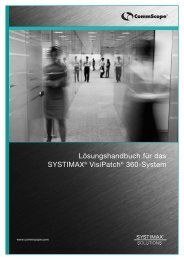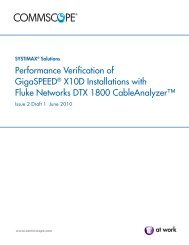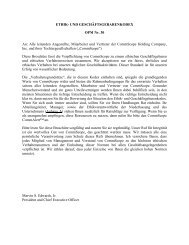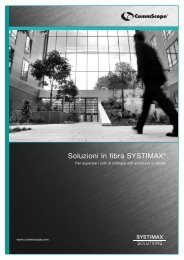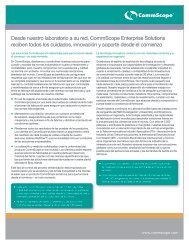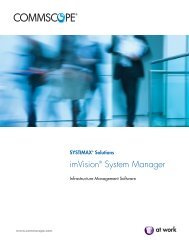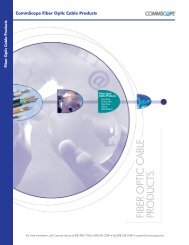Active Antennas: The Next Step in Radio and Antenna Evolution
Active Antennas: The Next Step in Radio and Antenna Evolution
Active Antennas: The Next Step in Radio and Antenna Evolution
You also want an ePaper? Increase the reach of your titles
YUMPU automatically turns print PDFs into web optimized ePapers that Google loves.
<strong>Active</strong> <strong><strong>Antenna</strong>s</strong>:<br />
<strong>The</strong> <strong>Next</strong> <strong>Step</strong> <strong>in</strong> <strong>Radio</strong> <strong>and</strong><br />
<strong>Antenna</strong> <strong>Evolution</strong><br />
WP-105435-EN (10/11) 1<br />
Kev<strong>in</strong> L<strong>in</strong>ehan<br />
VP, Chief Technology Officer, <strong>Antenna</strong> Systems<br />
Dr. Rajiv Ch<strong>and</strong>rasekaran<br />
Director of Technology Development, RF Power Amplifiers
TABLE OF CONTENTS<br />
1 INTRODUCTION.......................................................................................................................... 3<br />
2 RADIO ARCHITECTURE EVOLUTION....................................................................................... 3<br />
3 ACTIVE ANTENNA SYSTEM (AAS) ARCHITECTURE .............................................................. 5<br />
4 AAS BENEFITS............................................................................................................................ 6<br />
4.1 Site Footpr<strong>in</strong>t......................................................................................................................... 6<br />
4.2 Improved System Availability ................................................................................................ 6<br />
4.3 RF Plann<strong>in</strong>g with Advanced <strong>Antenna</strong> Tilt Features .............................................................. 7<br />
4.3.1 Tilt by St<strong>and</strong>ard.............................................................................................................. 8<br />
4.3.2 Separate Tx <strong>and</strong> Rx Tilt ................................................................................................. 8<br />
4.3.3 Tilt by Carrier ................................................................................................................. 8<br />
4.3.4 Self Optimiz<strong>in</strong>g Networks (SON) <strong>and</strong> Advanced Beam-tilt Features............................. 9<br />
5 FAMILY OF AAS ARCHITECTURES .......................................................................................... 9<br />
5.1 Integrated RRH with Passive <strong>Antenna</strong>.................................................................................. 9<br />
5.2 Distributed Amplifiers ............................................................................................................ 9<br />
5.3 Redundancy for Integrated RRH with Passive <strong>Antenna</strong>....................................................... 9<br />
5.4 Distributed Transceivers with Sub-arrays ............................................................................. 9<br />
5.5 <strong>Antenna</strong> Comb<strong>in</strong>ations.......................................................................................................... 9<br />
6 SUMMARY ................................................................................................................................. 10<br />
TABLE OF FIGURES<br />
Figure 1: Market trends <strong>and</strong> result<strong>in</strong>g radio architecture evolution. .................................................... 3<br />
Figure 2: Cell site architecture evolution. ............................................................................................ 4<br />
Figure 3: <strong>Active</strong> antenna architecture compared with a remote radio head plus antenna.................. 5<br />
Figure 4: Self-heal<strong>in</strong>g of beam patterns for improved system availability........................................... 7<br />
Figure 5: RF plann<strong>in</strong>g with advanced tilt features. .............................................................................. 8<br />
Figure 6: A high-b<strong>and</strong> active-passive array....................................................................................... 10<br />
Figure 7: A 700 MHz active antenna developed by CommScope <strong>in</strong> partnership with Ubidyne........ 11<br />
WP-105435-EN (10/11) 2
1 INTRODUCTION<br />
In this white paper we exam<strong>in</strong>e the evolution of cell site architectures from legacy systems to active<br />
antennas. We outl<strong>in</strong>e the market trends <strong>and</strong> requirements that are driv<strong>in</strong>g this transition <strong>and</strong><br />
describe the technological <strong>in</strong>novations be<strong>in</strong>g <strong>in</strong>troduced to meet these requirements. We then<br />
describe the benefits of the active antenna architecture over traditional implementations <strong>and</strong><br />
demonstrate the benefits to the operator from a total cost of ownership. We also describe a family of<br />
active antenna architectures that can be adapted to meet specific requirements from an end<br />
customer. F<strong>in</strong>ally, we describe the evolution of active antennas arrays from simple l<strong>in</strong>ear arrays to<br />
more complex multi-b<strong>and</strong>, multi-column arrays.<br />
2 RADIO ARCHITECTURE EVOLUTION<br />
Several key factors are driv<strong>in</strong>g the evolution of cell site architectures. <strong>The</strong> primary drive is the<br />
<strong>in</strong>creas<strong>in</strong>g dem<strong>and</strong> for b<strong>and</strong>width <strong>and</strong> capacity. This dem<strong>and</strong> is be<strong>in</strong>g address by i) new radio<br />
technologies like HSPA <strong>and</strong> LTE, ii) deployment of new frequency b<strong>and</strong>s for cellular radio<br />
transmission, <strong>and</strong> iii) <strong>in</strong>crease <strong>in</strong> the number of carriers <strong>and</strong> channels (b<strong>and</strong>width).<br />
While new 3G <strong>and</strong> 4G technologies like HSPA+ <strong>and</strong> LTE are be<strong>in</strong>g <strong>in</strong>troduced there is also a need<br />
to cont<strong>in</strong>ue to support legacy technologies like GSM <strong>and</strong> CDMA for the foreseeable future.<br />
Consequently, radio networks are be<strong>in</strong>g required to support multiple technologies (GSM, UMTS <strong>and</strong><br />
LTE or CDMA, WiMAX, <strong>and</strong> LTE) <strong>in</strong> multiple frequency b<strong>and</strong>s simultaneously. <strong>The</strong>refore, there is a<br />
grow<strong>in</strong>g need to <strong>in</strong>tegrate the electronics <strong>and</strong> hardware <strong>in</strong> a typical base-station to m<strong>in</strong>imize site<br />
footpr<strong>in</strong>t <strong>and</strong> lower costs.<br />
Figure 1: Market trends <strong>and</strong> result<strong>in</strong>g radio architecture evolution.<br />
Over the last decade, cell site architectures have been evolv<strong>in</strong>g from the legacy cell site architecture<br />
where large radios are located remote from the antennas, to an architecture where<strong>in</strong> a separate RF<br />
portion of the radio can be located more closely to the antenna. This separation of the digital radio,<br />
BBU (Base B<strong>and</strong> Unit), from the analog radio, RRH (Remote <strong>Radio</strong> Head), allows for a reduction of<br />
the equipment foot pr<strong>in</strong>t at the site <strong>and</strong> for a more efficient operation of the network. A digital fiber<br />
optic l<strong>in</strong>k provides the connection between the BBU <strong>and</strong> RRH.<br />
WP-105435-EN (10/11) 3
BTS<br />
(Channel<br />
Cards,<br />
<strong>Radio</strong>s,<br />
Amplifiers,<br />
Filters)<br />
<strong>The</strong> Past<br />
Conventional<br />
Passive<br />
<strong><strong>Antenna</strong>s</strong><br />
RET Coax<br />
Jumpers<br />
Masthead<br />
Amplifiers<br />
Coax<br />
Cables<br />
Base<br />
Station<br />
Server<br />
Channel<br />
Cards<br />
WP-105435-EN (10/11) 4<br />
<strong>The</strong> Present<br />
Remote <strong>Radio</strong> Head<br />
RET<br />
Passive<br />
<strong><strong>Antenna</strong>s</strong><br />
Coaxial<br />
Cables<br />
Remote<br />
<strong>Radio</strong><br />
Head<br />
Figure 2: Cell site architecture evolution.<br />
Base<br />
Station<br />
Server<br />
<strong>The</strong> Future<br />
<strong>Active</strong> <strong><strong>Antenna</strong>s</strong><br />
<strong>The</strong> next stage <strong>in</strong> the evolution of the site architecture is the actual <strong>in</strong>tegration of the radio <strong>in</strong>to the<br />
antenna <strong>and</strong> the distribution of the radio functionality across the antenna elements. This is an active<br />
antenna.<br />
Channel<br />
Cards
3 ACTIVE ANTENNA SYSTEM (AAS) ARCHITECTURE<br />
A s<strong>in</strong>gle sector architecture for an LTE active antenna system that supports 2x2 MIMO is depicted<br />
<strong>in</strong> Figure 3. For comparison, the equivalent implementation us<strong>in</strong>g an RRH is also shown.<br />
Figure 3: <strong>Active</strong> antenna architecture compared with a remote radio head plus antenna.<br />
Both the AAS <strong>and</strong> RRH are connected to a baseb<strong>and</strong> unit with a high-speed serial l<strong>in</strong>k as def<strong>in</strong>ed<br />
by the Common Public <strong>Radio</strong> Interface (CPRI), Open Base Station Architecture Initiative (OBSAI),<br />
or Open <strong>Radio</strong> Interface (ORI). <strong>The</strong> high speed serial l<strong>in</strong>k is used to transport the Tx <strong>and</strong> Rx signals<br />
from the BBU to the RRH or AAS. In an RRH, the downl<strong>in</strong>k (Tx) signal is digitally upconverted <strong>and</strong><br />
amplified on the downl<strong>in</strong>k path. Correspond<strong>in</strong>gly the analog upl<strong>in</strong>k (Rx) signal is processed by a low<br />
noise amplifier (LNA), downconverted <strong>and</strong> digitized. <strong>The</strong> duplexed outputs from the RRH feed a<br />
passive antenna array via a corporate feed network with RET support. <strong>The</strong> RRH comprises two<br />
transceivers, one for each MIMO path. Each transceiver <strong>in</strong>corporates an upconverter, an amplifier,<br />
an LNA, a downconverter, <strong>and</strong> a duplexer.<br />
In an active antenna, each element <strong>in</strong> the antenna array is connected to a separate transceiver<br />
element. A typical AAS system may therefore have multiple transceivers (for example 8-16). S<strong>in</strong>ce<br />
there are many more transceivers/amplifiers <strong>in</strong> an AAS, each amplifier <strong>in</strong> an AAS delivers a much<br />
lower power when compared to an amplifier <strong>in</strong> an equivalent RRH.<br />
WP-105435-EN (10/11) 5
4 AAS BENEFITS<br />
<strong>The</strong> benefits of an active antenna architecture over an RRH based site architecture are many. First,<br />
there is a potential to significantly reduce the site footpr<strong>in</strong>t. Second, the distribution of radio<br />
functions with<strong>in</strong> the antenna results <strong>in</strong> built-<strong>in</strong> redundancy <strong>and</strong> improved thermal performance,<br />
which can result <strong>in</strong> higher system availability (lower failure rates). Third, distributed transceivers can<br />
support a host of advanced electronic beam-tilt features that can enable improvements <strong>in</strong> network<br />
capacity <strong>and</strong> coverage; hence, it has the potential to lower capital <strong>and</strong> operational costs. Each of<br />
these features shall now be described <strong>in</strong> the follow<strong>in</strong>g sections.<br />
4.1 Site Footpr<strong>in</strong>t<br />
<strong>The</strong> first obvious benefit with the <strong>in</strong>tegration of the radio with<strong>in</strong> the antenna is the elim<strong>in</strong>ation of<br />
several components like cables, connectors, <strong>and</strong> mount<strong>in</strong>g hardware <strong>and</strong> an overall reduction <strong>in</strong> the<br />
physical tower space required. By <strong>in</strong>tegrat<strong>in</strong>g the remote radio head functionality <strong>in</strong>to the antenna,<br />
the aesthetics of the site can be improved <strong>and</strong> w<strong>in</strong>d load reduced. <strong>The</strong> follow<strong>in</strong>g table compares the<br />
hardware required for a three sector BTS us<strong>in</strong>g an RRH-based solution with an <strong>Active</strong> <strong>Antenna</strong><br />
System (AAS). As can be seen from the table, there is a significant reduction <strong>in</strong> the number of<br />
components <strong>in</strong> an AAS.<br />
RRH + Passive <strong>Antenna</strong> <strong>Active</strong> <strong>Antenna</strong><br />
High Power RF Cables 6 -<br />
Mount<strong>in</strong>g Brackets 6 3<br />
RET Controller 3 -<br />
Table 1: Typical components <strong>in</strong> a three-sector, s<strong>in</strong>gle-b<strong>and</strong>, cell site.<br />
In addition to the cost benefits due to reduction <strong>in</strong> the number of components, further sav<strong>in</strong>gs can<br />
be potentially achieved with lower tower leas<strong>in</strong>g costs <strong>and</strong> lower <strong>in</strong>stallation costs.<br />
4.2 Improved System Availability<br />
Due to its <strong>in</strong>herent architecture, an AAS can offer significant improvements <strong>in</strong> system availability<br />
over an RRH based system. <strong>The</strong> <strong>in</strong>crease comes about because of two factors:<br />
i) Improved thermal marg<strong>in</strong><br />
<strong>The</strong> active antenna architecture can elim<strong>in</strong>ate a substantial portion of the power losses <strong>in</strong> the RF<br />
feeder cables when compared to a conventional BTS. Though an RRH can provide a similar benefit,<br />
the AAS goes further by elim<strong>in</strong>at<strong>in</strong>g the need for even a short jumper cable between the RRH<br />
output <strong>and</strong> the antenna. Additionally, the active antenna can support an electronic beam tilt without<br />
requir<strong>in</strong>g a Remote Electrical Tilt (RET) feeder network. This further reduces the power loss for an<br />
AAS when compared to an RRH with a RET. In most configurations this can <strong>in</strong>crease the power<br />
delivered to the antenna when compared with an RRH. <strong>The</strong> additional marg<strong>in</strong> can be used to lower<br />
the overall thermal dissipation <strong>in</strong> the amplifiers.<br />
Further, with the radios <strong>in</strong>tegrated directly <strong>in</strong>to the antenna hous<strong>in</strong>g, <strong>and</strong> with replacement of a small<br />
number of large amplifiers with many small amplifiers, the heat is spread over the larger antenna<br />
structure as opposed to the smaller RRH or amplifier shelf. This availability of higher surface area<br />
for heat dissipation results lower temperature rises <strong>in</strong> the components, which results <strong>in</strong> improved<br />
thermal marg<strong>in</strong>s <strong>and</strong> better reliability.<br />
WP-105435-EN (10/11) 6
ii) Redundancy with Graceful Degradation <strong>and</strong> Self-Heal<strong>in</strong>g<br />
<strong>The</strong> distributed <strong>and</strong> redundant architecture of the AAS, where<strong>in</strong> each antenna element is fed by its<br />
own transceiver, provides reliability benefits as the failure of one transceiver does not cause a<br />
critical failure. <strong>The</strong> system is <strong>in</strong>telligent <strong>and</strong> can sense a transceiver failure. When a transceiver<br />
does fail, the amplitude <strong>and</strong> phases on the rema<strong>in</strong><strong>in</strong>g elements are automatically adjusted digitally<br />
to compensate for the elevation beam distortion <strong>and</strong> the reduction of EIRP on the horizon. With the<br />
appropriate siz<strong>in</strong>g of the amplifiers <strong>and</strong> <strong>in</strong>telligent readjustment of the amplitudes <strong>and</strong> phases, the<br />
AAS can be designed to have m<strong>in</strong>imal or no loss <strong>in</strong> coverage performance with a s<strong>in</strong>gle transceiver<br />
failure <strong>and</strong> m<strong>in</strong>imal degradation with two transceiver failures. S<strong>in</strong>ce the likelihood of more than one<br />
transceiver fail<strong>in</strong>g <strong>in</strong> a s<strong>in</strong>gle AAS is m<strong>in</strong>imal, very high system availabilities can be achieved.<br />
Normal Pattern<br />
5° tilt<br />
E1<br />
E1’<br />
E2<br />
E2’<br />
…<br />
....<br />
....<br />
En<br />
En’<br />
-5dB<br />
-10dB<br />
-15dB<br />
-20dB<br />
4dB<br />
5° tilt<br />
S<strong>in</strong>gle Failure<br />
Before Compensation<br />
-10dB<br />
-15dB<br />
-20dB<br />
Figure 4: Self-heal<strong>in</strong>g of beam patterns for improved system availability.<br />
S<strong>in</strong>ce the AAS can be designed to have m<strong>in</strong>imal loss <strong>in</strong> performance with a s<strong>in</strong>gle transceiver<br />
failure, repairs <strong>and</strong> site upgrades for failed units can be delayed <strong>and</strong> scheduled. For a site with<br />
several sectors <strong>and</strong> b<strong>and</strong>s, multiple unscheduled repair visits (as would be the case for an RRH<br />
based system) can be replaced by a s<strong>in</strong>gle scheduled visit that is less frequent. This can<br />
significantly reduce the operational costs for operators.<br />
4.3 RF Plann<strong>in</strong>g with Advanced <strong>Antenna</strong> Tilt Features<br />
-5dB<br />
Another critical benefit of an AAS is the unique ability to electronically tilt elevation beams by hav<strong>in</strong>g<br />
<strong>in</strong>dependent baseb<strong>and</strong> control of the phase, amplitude, <strong>and</strong> delay of <strong>in</strong>dividual carriers on each<br />
antenna element. This supports multi-mode systems where different carriers <strong>in</strong> the same frequency<br />
b<strong>and</strong>, with different air <strong>in</strong>terfaces, may require different tilt orientations. <strong>The</strong> flexibility with tilt control<br />
<strong>in</strong> AAS enables advanced RF plann<strong>in</strong>g features, much of which can potentially reduce the cost to<br />
operators by reduc<strong>in</strong>g the number of sites required. Several versions of tilt control are described <strong>in</strong><br />
the follow<strong>in</strong>g sections.<br />
WP-105435-EN (10/11) 7<br />
E1<br />
E1’<br />
E2<br />
E2’<br />
FAILED<br />
ELEMENT<br />
…<br />
....<br />
....<br />
En<br />
En’<br />
2° tilt<br />
S<strong>in</strong>gle Failure<br />
After Compensation<br />
E1<br />
E1’<br />
E2<br />
E2’<br />
FAILED<br />
ELEMENT<br />
…<br />
....<br />
....<br />
En<br />
En’<br />
-5dB<br />
-10dB<br />
-15dB<br />
-20dB<br />
4dB
Tilt by Carrier- Vertical Sectorization<br />
• Multiple beams per carrier enables vertical<br />
sub-sectorization for capacity enhancement<br />
Tilt by St<strong>and</strong>ard– Air Interface<br />
#1 #2 #3<br />
• Tilt per st<strong>and</strong>ard (GSM/UMTS/LTE)<br />
- Simplifies RAN shar<strong>in</strong>g<br />
WP-105435-EN (10/11) 8<br />
Tx / Rx Tilt Optimization<br />
• Significant capacity improvement<br />
- Improves h<strong>and</strong>set battery life<br />
Figure 5: RF plann<strong>in</strong>g with advanced tilt features.<br />
4.3.1 Tilt by St<strong>and</strong>ard<br />
In a legacy cell site, GSM/GPRS/EDGE or UMTS carriers may provide adequate coverage, but<br />
when an LTE carrier is newly <strong>in</strong>troduced to the same site, it may need to be downtilted differently<br />
than the legacy carriers as the l<strong>in</strong>k budgets for LTE <strong>and</strong> UMTS may be different. This is feasible<br />
with AAS.<br />
4.3.2 Separate Tx <strong>and</strong> Rx Tilt<br />
<strong>The</strong> electronic tilt capability also allows for the separate beam tilt<strong>in</strong>g <strong>and</strong> optimization of the Tx<br />
(downl<strong>in</strong>k) <strong>and</strong> Rx (upl<strong>in</strong>k) paths. This might be critical when the l<strong>in</strong>k budgets for the Tx <strong>and</strong> Rx<br />
paths are unequal. It may also be used to optimize cell radii when the physical layer (modulation<br />
scheme) for the Tx <strong>and</strong> Rx paths is different, as is the case with LTE.<br />
4.3.3 Tilt by Carrier<br />
For maximum flexibility, tilt can be adjusted on a per-carrier basis. This has some <strong>in</strong>terest<strong>in</strong>g<br />
applications such as vertical sectorization <strong>in</strong> LTE <strong>and</strong> RAN shar<strong>in</strong>g for UMTS.<br />
4.3.3.1 Vertical Sectorization<br />
In UMTS/LTE networks, add<strong>in</strong>g sectors <strong>in</strong> the vertical plane have been proposed for improv<strong>in</strong>g<br />
system capacity. In a typical implementation, the first carrier may cover an <strong>in</strong>ner sector whereas a<br />
second carrier covers an outer sector. For LTE, this has been shown <strong>in</strong> simulation to provide<br />
significant capacity benefits.<br />
4.3.3.2 RAN Shar<strong>in</strong>g<br />
As multiple operators vie for precious real estate on tower tops, antenna shar<strong>in</strong>g <strong>and</strong> RAN shar<strong>in</strong>g<br />
amongst two or more operators has been proposed. In such a scheme a RAN that supports a<br />
multicarrier UMTS system is shared by two operators with each operator controll<strong>in</strong>g/own<strong>in</strong>g one or<br />
more of the <strong>in</strong>dividual carriers. S<strong>in</strong>ce the RF plann<strong>in</strong>g <strong>and</strong> site deployments are likely to differ<br />
among operators, each UMTS carrier may need to be tilted by different amounts <strong>in</strong> order for each<br />
operator to achieve optimal network performance.<br />
Tx<br />
Rx
4.3.4 Self Optimiz<strong>in</strong>g Networks (SON) <strong>and</strong> Advanced Beam-tilt Features<br />
Look<strong>in</strong>g ahead, optimiz<strong>in</strong>g beam tilt on a per-carrier basis based on active channel load<strong>in</strong>g us<strong>in</strong>g<br />
advanced SON algorithms as envisioned <strong>in</strong> LTE can provide even higher network efficiencies.<br />
5 FAMILY OF AAS ARCHITECTURES<br />
<strong>The</strong> AAS architecture described <strong>in</strong> the preced<strong>in</strong>g Section 3 describes an architecture that can<br />
support the full range of features outl<strong>in</strong>ed <strong>in</strong> Section 4. As such, an AAS may be designed to<br />
support a subset of the above features by adopt<strong>in</strong>g vary<strong>in</strong>g configurations. Some of these are<br />
described <strong>in</strong> the follow<strong>in</strong>g sections.<br />
5.1 Integrated RRH with Passive <strong>Antenna</strong><br />
<strong>The</strong> simplest AAS is a mechanical <strong>in</strong>tegration of the passive antenna with an RRH. This offers the<br />
benefit of reduc<strong>in</strong>g the site footpr<strong>in</strong>t <strong>and</strong> associated leas<strong>in</strong>g/<strong>in</strong>stallation costs. <strong>The</strong> additional surface<br />
area afforded by the antenna can also offer some thermal benefits. Elim<strong>in</strong>ation of the RF jumper<br />
cables from the RRH to the antenna can offer some further benefits.<br />
5.2 Distributed Amplifiers<br />
Another variation that can be envisioned is an AAS with distributed amplifiers. S<strong>in</strong>ce the amplifiers<br />
are one of the highest power dissipat<strong>in</strong>g elements <strong>in</strong> the system, a distributed amplifier (one per<br />
antenna element) with a common up/down converter can offer some of the benefits of an AAS such<br />
as improved thermal design <strong>and</strong> <strong>in</strong>cremental improvement <strong>in</strong> system availability due to the<br />
redundant amplifiers. Such a system cannot, however, support the full range of RF tilt controls.<br />
5.3 Redundancy for Integrated RRH with Passive <strong>Antenna</strong><br />
As described <strong>in</strong> preced<strong>in</strong>g sections, <strong>in</strong>corporat<strong>in</strong>g redundant subsystems with an <strong>in</strong>telligent failure<br />
recovery mechanism can improve the overall system availability. A similar concept can be applied to<br />
the Integrated RRH with Passive <strong>Antenna</strong>. Redundancy can be added to selective subsystems that<br />
have a high failure rate (for example, power supplies or amplifiers) to reap the benefits of a system<br />
with higher availability. Such a system can lower the site ma<strong>in</strong>tenance costs, at the expense of<br />
additional <strong>in</strong>itial expense for the redundant systems.<br />
5.4 Distributed Transceivers with Sub-arrays<br />
A full featured AAS would require a transceiver at every antenna element. However, a compromise<br />
may be achievable where the number of transceivers is greater than that <strong>in</strong> an RRH but lower than<br />
the number of antenna elements. In this architecture, each transceiver feeds several sub-arrays that<br />
are l<strong>in</strong>early arranged to form the complete antenna array. Judicious design of the antenna <strong>and</strong> its<br />
sub-arrays can achieve all of the benefits of an AAS while m<strong>in</strong>imiz<strong>in</strong>g system cost <strong>and</strong> complexity.<br />
5.5 <strong>Antenna</strong> Comb<strong>in</strong>ations<br />
As multiple b<strong>and</strong>s <strong>and</strong> air <strong>in</strong>terface st<strong>and</strong>ards are <strong>in</strong>troduced, AAS architectures shall evolve from<br />
s<strong>in</strong>gle-b<strong>and</strong> active arrays to active-passive antenna arrays. An example of a high-b<strong>and</strong> activepassive<br />
array is shown <strong>in</strong> Figure 6. In a typical active-passive configuration, the active array is used<br />
to deploy new (4G) services whereas the passive array is used to support legacy (2G, 3G)<br />
<strong>in</strong>stallations. <strong>The</strong> CommScope active-passive array borrows from our <strong>in</strong>dustry lead<strong>in</strong>g multib<strong>and</strong><br />
antenna designs. Specifically, the passive array can be designed with broadb<strong>and</strong> elements that can<br />
cover a highb<strong>and</strong> as broad as 1710 – 2690 MHz.<br />
WP-105435-EN (10/11) 9
Figure 6: A high-b<strong>and</strong> active-passive array.<br />
As more legacy <strong>in</strong>stallations are upgraded to 4G (LTE), a dual column active-active array<br />
configuration can also be envisioned, with each active column support<strong>in</strong>g a separate b<strong>and</strong>.<br />
Ultimately, multi-column active arrays that can support advanced beam pattern controls <strong>in</strong> azimuth<br />
<strong>and</strong> elevation shall be <strong>in</strong>troduced.<br />
6 SUMMARY<br />
<strong>The</strong> key take-away from the discussions <strong>in</strong> the preced<strong>in</strong>g sections is that AAS can lower the total<br />
cost of ownership for operators. <strong>The</strong> reduction <strong>in</strong> site footpr<strong>in</strong>t can lower capital expense, <strong>in</strong>stallation<br />
<strong>and</strong> ma<strong>in</strong>tenance costs. <strong>The</strong> improved system availability can reduce repair <strong>and</strong> ma<strong>in</strong>tenance costs,<br />
while simultaneously improv<strong>in</strong>g system up-time. <strong>The</strong> advanced tilt features can enable capacity <strong>and</strong><br />
coverage improvements, result<strong>in</strong>g <strong>in</strong> lower network deployment costs. Ultimately, smart networks<br />
with AAS <strong>and</strong> SON can further improve network efficiencies.<br />
CommScope has been conduct<strong>in</strong>g pioneer<strong>in</strong>g work on active antennas systems s<strong>in</strong>ce 2001, when<br />
prototypes were built <strong>and</strong> tested <strong>in</strong> our corporate R&D labs <strong>in</strong> Richardson, Texas. Work cont<strong>in</strong>ues<br />
today <strong>in</strong> CommScope’s radio <strong>and</strong> antenna R&D facilities. In 2007, CommScope <strong>in</strong>itiated a jo<strong>in</strong>t<br />
development of active antennas with a partner, Ubidyne. (Ubidyne is a start-up company focus<strong>in</strong>g<br />
on develop<strong>in</strong>g custom chips <strong>and</strong> transceiver systems for active antenna.) As part of this<br />
development CommScope has been manufactur<strong>in</strong>g active antennas for various field trials over the<br />
last several years.<br />
WP-105435-EN (10/11) 10
Figure 7: A 700 MHz active antenna developed by CommScope <strong>in</strong> partnership with Ubidyne.<br />
With a long successful history of provid<strong>in</strong>g high performance, cost competitive antenna <strong>and</strong> radio<br />
products to the <strong>in</strong>dustry, as well as extensive experience <strong>in</strong> supply<strong>in</strong>g fiber optic, coaxial, <strong>and</strong><br />
twisted pair cables, CommScope is <strong>in</strong> a unique position to make active antenna solutions a success<br />
for our customers.<br />
WP-105435-EN (10/11) 11



